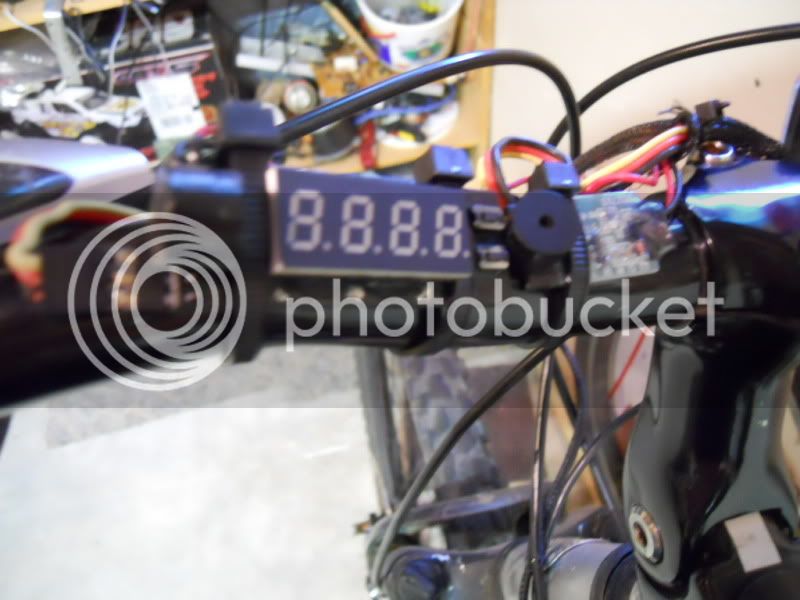Metallover
10 kW
Hobbyking Voltage and Temperature Monitor Review
By Metallover

I have owned my VT monitor for a few months now. You can get one at hobbycity for $8.50. It is a low voltage alarm and high temperature alarm all in one. The screen changes from voltage to temperature every second or two. The temperature probe has three wires to it and attaches to the main unit with a 3-pin jst connector like those found in RC radio systems. The device measures temperatures up to 150 degrees celsius and takes 4-26v input. Due to the 26v max rating, this won't be the best for e-bikes. You will have to measure just one cell or a group of cells if you want to take advantage of the lvc alarm.
The unit came neatly packaged in it's own box with lots of padding inside. It comes with an instruction booklet which shows how to program it. Programming is very simple. There are two buttons on the right side of the display. Press and hold the bottom one to set the temperature. After holding the button it will start going through temperatures in increments of one degree. The same goes for the voltage programming, just hold the top button. All of this is explained in the manual and I can't imagine anyone not being able to figure it out. It is very simple.
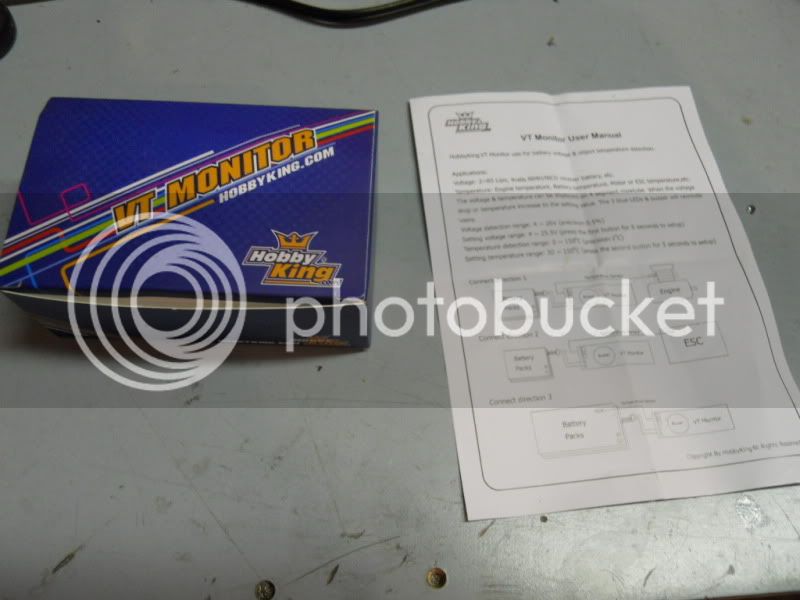
When the voltage drops below the set voltage or the temperature gets above the set temperature, three bright led's will light up and a buzzer will sound. The buzzer is pretty loud; I don't think the buzzer being too quiet would ever be a problem. Even if you don't hear the buzzer, the blue led's are very bright and they should catch your attention.
One flaw I found is the screen brightness. Under direct sunlight, you can't make out what it is displaying. I don't know if this is due to the brightness of the display or the opacity of the shrinkwrap, but it is a problem nonetheless. This isn't too much of a problem however because the alarm still works and if you want to see what's on the screen you can block the sun with your hand.
This device isn't water sealed. It wasn't meant to be either, however the bottom of the board has some foam glued to it which should prevent any water damage there. If any moisture gets on the other parts it could cause problems and false alarms. I am going to work some magic in the near future with liquid electrical tape, and I'll post on here when I get done. I have also had a few false alarms due to bad connections leading to the sensor, so when running the sensor wire to your motor make sure to take your time and make sure you don't make any bad connections.
_____
The temperature probe is a little over an inch long by 5-6mm wide. I attached it to my windings with some epoxy. To test it I turned it on then I used a hairdryer and warmed up the sensor. I then used my infared temp meter and measure the temp of probe I had just heated up. They were both the same. It seems like a pretty accurate device judging by that one test.
Today I went on a 4-5 mile (round trip) ride. when I got to my destination the meter showed 72*c, which works out to 162*f at the windings. I was riding hard like a usually do in the city, and the temp seemed right. The outside of the motor was just a little warm. I should have brought my other infared temp gauge so I could give you a number but I forgot. When I got back it read 63*c. I had the alarm set, conservatively, at 85*c, and as expected it never went off, because I never neared the set temperature.
Pic of monitor without shrink, there is a scratch I made under the bottom button
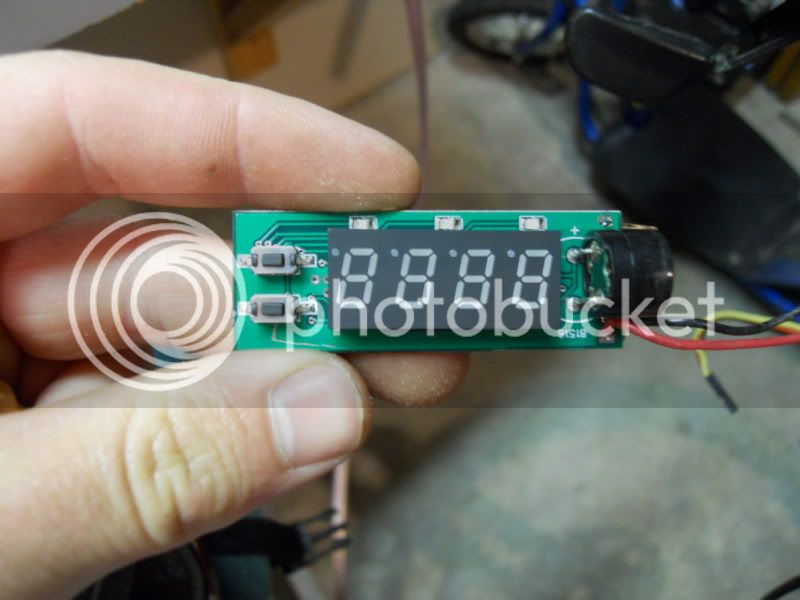
pic of temp. sensor installed in motor. It is on the right side
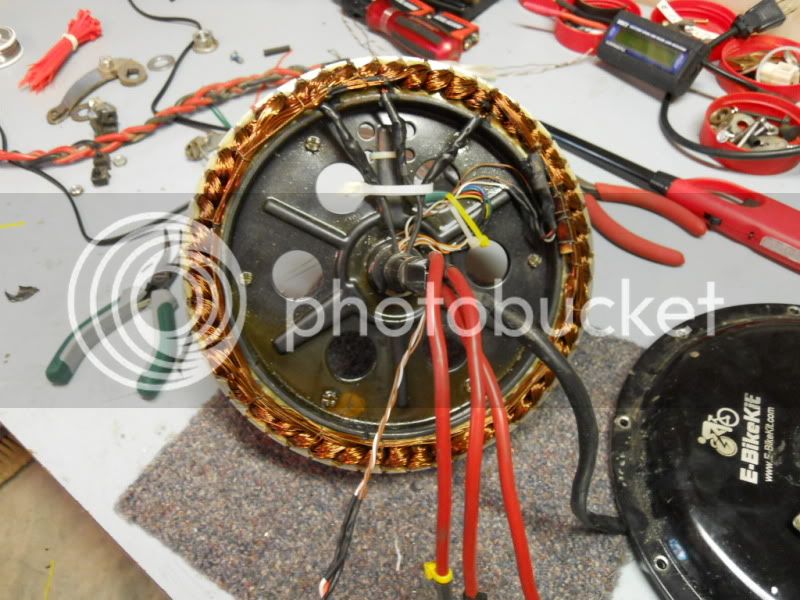
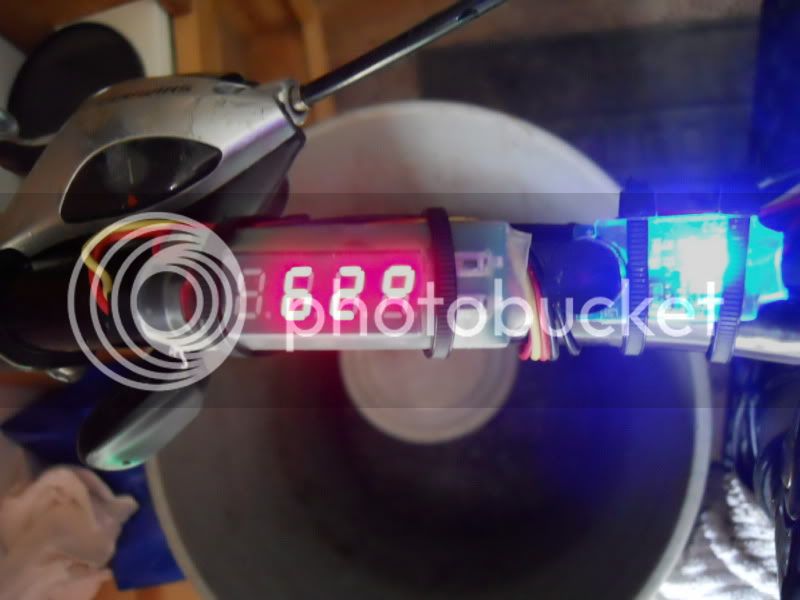
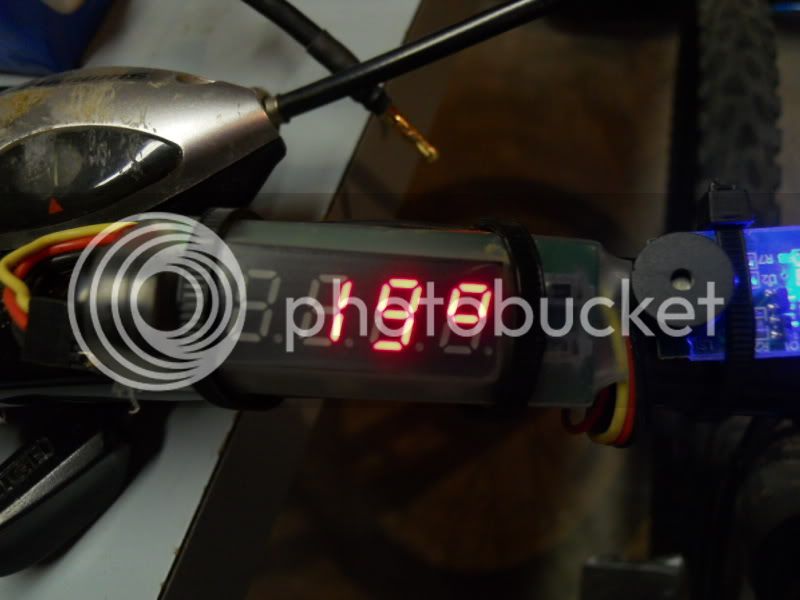
_____
Overall, I highly recommend the hobbyking vt monitor to all e-bikers, especially those pushing the limits of their motors. The low input voltage range limits it's usefulness/compatibility for e-bikes, however the temperature setting is the real reason to get this. The low price tag of $8.50 makes this not only a way to measure your motor temp, but possibly the best way because of the high temp alarm. The screen can't be read in direct sunlight and it only displays temperature in celsius, but those are just minor flaws that shouldn't distract you from the magic that is Hobbyking VT Monitor.
I give The hobbyking VT monitor 5 stars out of 5 and a big thumbs up.
By Metallover

I have owned my VT monitor for a few months now. You can get one at hobbycity for $8.50. It is a low voltage alarm and high temperature alarm all in one. The screen changes from voltage to temperature every second or two. The temperature probe has three wires to it and attaches to the main unit with a 3-pin jst connector like those found in RC radio systems. The device measures temperatures up to 150 degrees celsius and takes 4-26v input. Due to the 26v max rating, this won't be the best for e-bikes. You will have to measure just one cell or a group of cells if you want to take advantage of the lvc alarm.
The unit came neatly packaged in it's own box with lots of padding inside. It comes with an instruction booklet which shows how to program it. Programming is very simple. There are two buttons on the right side of the display. Press and hold the bottom one to set the temperature. After holding the button it will start going through temperatures in increments of one degree. The same goes for the voltage programming, just hold the top button. All of this is explained in the manual and I can't imagine anyone not being able to figure it out. It is very simple.

When the voltage drops below the set voltage or the temperature gets above the set temperature, three bright led's will light up and a buzzer will sound. The buzzer is pretty loud; I don't think the buzzer being too quiet would ever be a problem. Even if you don't hear the buzzer, the blue led's are very bright and they should catch your attention.
One flaw I found is the screen brightness. Under direct sunlight, you can't make out what it is displaying. I don't know if this is due to the brightness of the display or the opacity of the shrinkwrap, but it is a problem nonetheless. This isn't too much of a problem however because the alarm still works and if you want to see what's on the screen you can block the sun with your hand.
This device isn't water sealed. It wasn't meant to be either, however the bottom of the board has some foam glued to it which should prevent any water damage there. If any moisture gets on the other parts it could cause problems and false alarms. I am going to work some magic in the near future with liquid electrical tape, and I'll post on here when I get done. I have also had a few false alarms due to bad connections leading to the sensor, so when running the sensor wire to your motor make sure to take your time and make sure you don't make any bad connections.
_____
The temperature probe is a little over an inch long by 5-6mm wide. I attached it to my windings with some epoxy. To test it I turned it on then I used a hairdryer and warmed up the sensor. I then used my infared temp meter and measure the temp of probe I had just heated up. They were both the same. It seems like a pretty accurate device judging by that one test.
Today I went on a 4-5 mile (round trip) ride. when I got to my destination the meter showed 72*c, which works out to 162*f at the windings. I was riding hard like a usually do in the city, and the temp seemed right. The outside of the motor was just a little warm. I should have brought my other infared temp gauge so I could give you a number but I forgot. When I got back it read 63*c. I had the alarm set, conservatively, at 85*c, and as expected it never went off, because I never neared the set temperature.
Pic of monitor without shrink, there is a scratch I made under the bottom button

pic of temp. sensor installed in motor. It is on the right side



_____
Overall, I highly recommend the hobbyking vt monitor to all e-bikers, especially those pushing the limits of their motors. The low input voltage range limits it's usefulness/compatibility for e-bikes, however the temperature setting is the real reason to get this. The low price tag of $8.50 makes this not only a way to measure your motor temp, but possibly the best way because of the high temp alarm. The screen can't be read in direct sunlight and it only displays temperature in celsius, but those are just minor flaws that shouldn't distract you from the magic that is Hobbyking VT Monitor.
I give The hobbyking VT monitor 5 stars out of 5 and a big thumbs up.


